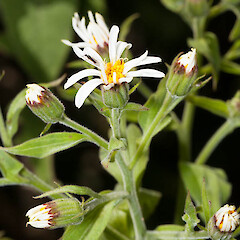Brachyglottis hectorii
Common name
Hector’s tree daisy
Synonyms
Senecio hectorii Buchanan
Family
Asteraceae
Flora category
Vascular – Native
Endemic taxon
Yes
Endemic genus
No
Endemic family
No
Structural class
Trees & Shrubs - Dicotyledons
NVS code
The National Vegetation Survey (NVS) Databank is a physical archive and electronic databank containing records of over 94,000 vegetation survey plots - including data from over 19,000 permanent plots. NVS maintains a standard set of species code abbreviations that correspond to standard scientific plant names from the Ngä Tipu o Aotearoa - New Zealand Plants database.
BRAHEC
Chromosome number
2n = 60
Current conservation status
The conservation status of all known New Zealand vascular plant taxa at the rank of species and below were reassessed in 2017 using the New Zealand Threat Classification System (NZTCS) – more information about this can be found on the NZTCS website. This report includes a statistical summary and brief notes on changes since 2012 and replaces all previous NZTCS lists for vascular plants.
Please note, threat classifications are often suggested by authors when publications fall between NZTCS assessment periods – an interim threat classification status has not been assessed by the NZTCS panel.
- Conservation status of New Zealand indigenous vascular plants, 2017 . 2018. Peter J. de Lange, Jeremy R. Rolfe, John W. Barkla, Shannel P. Courtney, Paul D. Champion, Leon R. Perrie, Sarah M. Beadel, Kerry A. Ford, Ilse Breitwieser, Ines Schönberger, Rowan Hindmarsh-Walls, Peter B. Heenan and Kate Ladley. Department of Conservation. Source: NZTCS and licensed by DOC for reuse under the Creative Commons Attribution 4.0 International licence.
2017 | Not Threatened
Previous conservation statuses
2012 | Not Threatened
2009 | Not Threatened
2004 | Not Threatened
Brief description
Large shrub with conspicuous white daisy flowers of north-western South Island. Leaves with distinctive feathery base, crowded at top of twigs, thin, margin with small teeth. Flowers around 5 cm wide, with radiating white petals and a yellow centre, sticky, in large clusters.
Distribution
Endemic. South Island. North-west Nelson to Rapahoe Range in Westland.
Habitat
Lowland to montane stream-sides and forest margins.
Detailed description
Shrub up to 4m tall. Branches stout, spreading, brittle, tomentose; leaves close-set towards tips of branchlets. Lamina 100-250 x 40-120 mm, membranous, broadly oblanceolate, more or less scaberulous above, thinly clad in cottony white tomentum below when young, coarsely acutely dentate serrate, pinnatifid to pinnate towards base and on short petiole up to 40 mm long; petiole clad in brownish hairs below. Corymbs large, terminal, lax, pedicels densely clad in stiff glandular pubescence. Capitula up to 50 mm diameter; phyllaries in two series, outer lanceolate, inner oblong-lanceolate, acute, margins membranous Ray-florets 8-12, ligules white, broad, spreading, approximately 20 mm long; achenes 4.5 mm long, linear, strongly grooved, glabrous; pappus-hairs up to 9 mm long, slender, rather rigid, finely barbellate.
Flowering
December - February (-June)
Flower colours
White, Yellow
Fruiting
January - April (-July)
Life cycle
Pappate achenes are dispersed by wind (Thorsen et al., 2009).
Etymology
brachyglottis: Name comes from the Greek words brachus meaning “short” and glottis meaning “the vocal apparatus of the larynx”
hectorii: Named after Sir James Hector, 19th century New Zealand geologist and botanist who was originally from Scotland
Attribution
Description adapted by M. Ward from Allan (1961).
References and further reading
Allan, H. H. 1961. Flora of New Zealand. Vol. 1. Wellington: Government Printer. pg. 747-748.
Thorsen, M. J.; Dickinson, K. J. M.; Seddon, P. J. 2009. Seed dispersal systems in the New Zealand flora. Perspectives in Plant Ecology, Evolution and Systematics 2009 Vol. 11 No. 4 pp. 285-309









